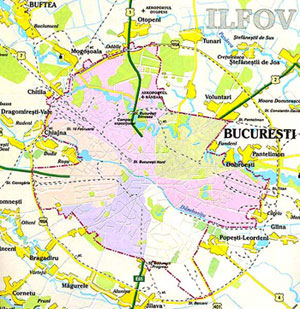 BUCHAREST
- THE CAPITAL
BUCHAREST
- THE CAPITAL
Bucharest, the largest and most important city in Romania, its main political,
administrative, economic, financial banking, education, scientific and cultural
centre. Situated in S-SE Romania, at an altitude of 60-90 m., on the rivers
Dambovita and Colentina, at 44º25’50” latitude north and
26º06’50” longitude east, approximately at the same longitude
as Helsinki and Johannesburg. The city has an area of 228 sq. km. and a population
of 2,016,000 (9% of the country’s total population and 15% of the urban
one), being the third most populated city in the region, after Athens and
Istanbul. Bucharest was first mentioned in 1459 as seat of Wallachia’s
ruler Vlad Tepes although the settlement dates back to the 14th century.
In the 17th-19th centuries it was the capital of Wallachia, and in 1862 it
became the capital of Romania. Its population grew from 122,000 (in 1859)
to 639,000 (in 1930) and to 1,452,000 in 1966. The first higher education
establishment was inaugurated here in 1694 (the St. Sava Academy); the University
dates back to 1864. Today the capital city has 21 higher education establishments
with over 100,000 students. Bucharest shelters the Romanian Orthodox Patriarchate
(founded in 1925), the Romanian Academy (founded in 1867), two national libraries,
40 museums, 230 churches, an opera house, an operetta theatre, two symphony
orchestras, and 20 drama theatres. With its 265,000 sq. m. of interior area,
the Parliament Palace, built before 1989, is the world’s second biggest
building after the Pentagon in Washington (which has 604,000 sq.m.). The
subway inaugurated in 1979 (today with lines totalling 60 km) made Romania
the 27th country in the world boasting such an urban transportation system.
Bucharest is not only a tourist
spot of prime importance, but also a gateway and starting point for tourist
destinations across the country. The large parks and the string of lakes
lend the city a distinct note of a “garden-city”. Time has not
radically changed the look of the capital, but only added fresh touches to
the old face. There are still many quiet streets, with houses still beautiful,
despite the signs of old age. The French-inspired buildings downtown, which
once were a reason to nickname the city “Little Paris”, shelter
museums, banks and other institutions. The 16th-17th centuries churches in
Bucharest should not be missed. In the Sfantu Gheorghe Church, built in 1698-1709,
the great ruling prince Constantin Brancoveanu was buried. The Romanians
consider him a hero; he was beheaded by Turks on the charge of being unloyal
to the Porte and his four sons sharedthe fate because they refused to abandon
their Christian faith. The National Art Museum displays the best works of
Romanian painters and sculptors. At the art galleries one can admire and
even buy paintings by contemporary artists who have already made a name for
themselves, or by emerging talents. The open-air Village Museum, built in
1936 and considered the second most important in Europe (after Stockholm)
is a fascinating place that show cases genuine peasant houses from all over
Romania. The Romanian Peasant Museum conveys the Romanians’ love for
their roots and traditions. After the fall of the communist regime, the “House
of the People”, built during Ceausescu’s disctaroship, now the
Parliament Palace, has become a major attraction in Bucharest. The second
biggest building in the world (after the Pentagon), it mirrors both the megalomania
of a dictator and the toil and sacrifices made by common people. Adding to
all this are several places nearby Buchares: the Snagov forest and lake (on
the isle in the midst of the lake there is a monastery where ruling Prince
Vlad the Impaler was probably buried), Mogo}oaia - with the Palace of Prince
Constantin Brancoveanu, the picturesque monasteries of Cernica and Pasarea,
the Baneasca Woods, and the Caldarusani, Lake and Monastery (built in the
17th century during the region of prince Matei Basarab).
